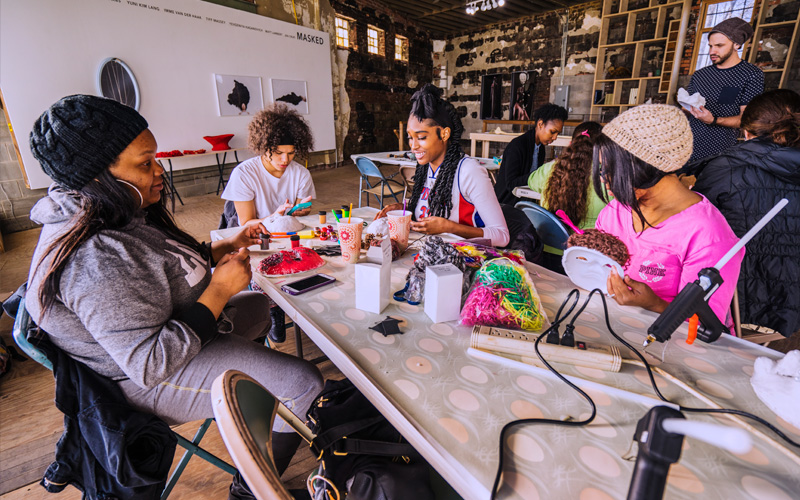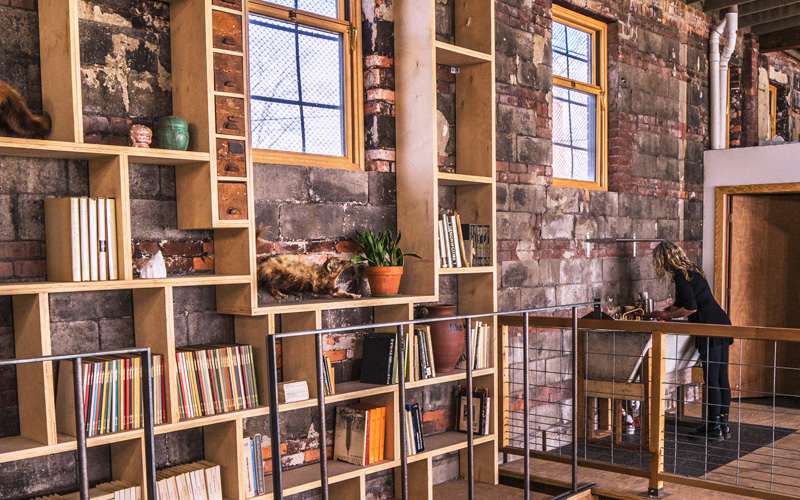Making Art Accessible for Detroit Neighborhoods
ANDREA ECKERT
Co-founder
Holding House
BFA Studio Art ‘03
They call it “Core City.” Maybe you have heard of it. In fact, if you have ever driven on Michigan Avenue in Southwest Detroit, you have cut right through. Most of its current residents have been here for years, even generations. The community is one that prides itself on hard work, grit, resilience, and helping those in need.
For years, there has never been an art presence or creative outlet in this part of the city. Well, not until 2013 when MSU Studio Art alumna (’03) Andrea Eckert and Child Development alumna (’00) Adrienne Dunkerley had a vision to make art accessible to all in this area by opening a gallery.
After searching for the right property, the right location, and the right community in Detroit, Eckert and Dunkerley took a risk buying an auction property in the heart of Core City.
“It was as rough as you can imagine,” Eckert said. “There was no heat, no electricity, and most of the floors were missing. You had to be careful where you walked once you were inside.”
During the renovation, it caught the eyes and curiosity of the neighborhood kids.
“The kids wanted to check out what was going on and see if they could help,” Eckert said. “It was then that we realized it could function as more than an art gallery.”

And in the summer of 2014, Eckert reached out to local nonprofit organizations to gauge their interest in partnering. The result? A new space that works with existing nonprofits and hosts activities and educational opportunities for anyone interested in art making in Detroit. The space is called Holding House.
Today, Holding House is an artist-run workspace that offers equitable art access to the entire Detroit community. It provides creative opportunities for intergenerational and intercultural community members to engage in the arts. Through multidisciplinary art experiences, Holding House serves as a resource for cultivating and promoting problem-solving, perseverance, and relationship-building through art making.
“This is it as far as community art space in Core City,” Eckert said. “People that go through the building, it is their first time in an art gallery or even making art. Seeing those parents and children experience art for the first time has been exciting.”
Eckert recently partnered with several professional emerging local artists and Alternatives for Girls, a local nonprofit serving homeless and at-risk girls to give these girls an opportunity to make masks with local artists for an exhibition called ‘Masked.’
“Exhibitions and workshops like these serve as a catalyst for conversation and a jumping off point with the women from Alternatives for Girls.”
“Exhibitions and workshops like these serve as a catalyst for conversation and a jumping off point with the women from Alternatives for Girls,” Eckert said. “With these overarching connections of art into life, the women acknowledge why people make art and how to use it as a vehicle for expression.”

As she envisions the future, Eckert believes there will be an influx of talent and energy being put forth in Detroit’s art culture over the next several years. She is quick to point out that community involvement is crucial to moving the art culture forward in the city.
“There is a lot of really strong community-minded people who are part of the creative culture in Detroit,” Eckert said. “This is changing how people experience art in residential communities.”
She says what she valued most about MSU’s Department of Art, Art History, and Design was the interdisciplinary approach they took towards the arts.
“The emphasis at MSU was on exploration, experimental approaches to cultivate a creative practice that encouraged growth and discovery.”
“The emphasis at MSU was on exploration, experimental approaches to cultivate a creative practice that encouraged growth and discovery,” Eckert said. “I was able to move fluidly through many art programs – ceramics, printmaking, and woodshop. That served me in terms of what I am doing now, since I have to wear different hats at Holding House. The program allowed me to find out what I wanted to do following graduation.”

Five or 10 years from now, Eckert hopes to have built lasting relationships around the city and to continue to grow the educational programming. It is important not only for her, but for her children as they will continue her legacy of positively affecting lives and communities through art.
“It’s what I want my kids seeing my work being…it is important they experience that firsthand.”
“What I have done here at Holding House I honor as part of my studio art practice,” she said. “It’s what I want my kids seeing my work being. For them to see the potential of what you can organize and the positive impact it makes on communities, it is important they experience that firsthand.”



